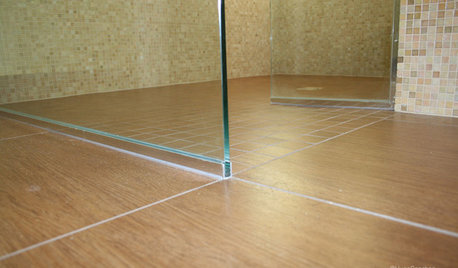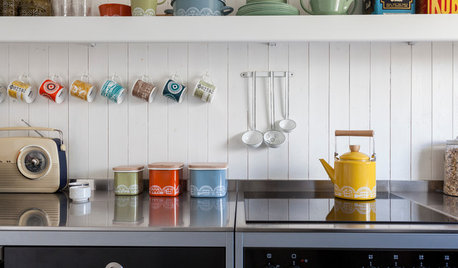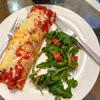Powdered coconut milk
Judi
last year
Featured Answer
Comments (15)
Judi
last yearRelated Discussions
Kefir Question--for Grainlady or Anyone
Comments (11)marita...my understanding of what you should receive when you purchase the grains online is a dried product that takes approx 7 days to fully rejuvenate. There are exact inst. on the net for how to reconstitute dry grains. I haven't heard of anyone sending out wet/slime grains :) There are no grains per se in my kefir since the weather has gotten cooler. But...today just to help out with your research I let a jar of kefir set out in a warmer place and it has indeed formed a large mass of grains floating on a bunch of clear whey. So it is indeed temp related. I had another jar of fresh milk and 2 tsp of grains sitting in a cool place in the kitchen since this AM and it has become my usual jar of soft yogurty type stuff with no separation and it is ready to go into the fridge to be used in a smoothy in the AM. All temp and time related. As I said...at cool temps it is highly unlikely that you are going to get any distinct grains/curds. It will all be soft cheesy stuff. If I were to put mine in a strainer most of it would stay in the strainer just as yogurt does. When it was hotter weather it drained out a lot of white and clear together and left drier distinct curds...again it is all temp related. I would not give up on what you have. It tastes pleasant...it smells pleasant. When the temps change so will your kefir. I hope you cont. to enjoy. I have now shared my grains and they are living in Montgomery AL and Lexington VA !! It is a wondrous process. c Oh..ps about resting the grains. I take 2 tsp every AM of the current kefir that I am going to eat and place it in a jar of fresh cold 2 % milk and leave it in a cool place for 12 hrs and then place it in the fridge over night...Next AM take out 2 tsp and place in cold milk and leave out....then in fridge and repeat. As far as rest...well they are in new milk every day and they are at a pretty cool temp and the source has been in the fridge all night fully fermented but very cool and waiting /resting. As my grains seem so happy I am not going to change anything. If your grains are happy and taste good I would say " yes" to the process you are following....See MoreMaking Kefir with Yogurt and Dry Milk
Comments (3)I don't think it's any less complicated, just another choice. I only use powdered milk and whey-based milk substitute products (since 1981) for drinking/cooking/baking and regularly make kefir with real kefir milk grains and powdered milk. The product I prefer using is Grandma's Country Cream non-fat dry milk (http://grandmascountryfoods.com/CountryCreamPowderedMilk/), which I purchase by the 25# bucket. For 25-years I made LOTS of yogurt using powdered milk products, but since making kefir, I only make yogurt a few times a year (at most) since kefir is better for you and is so much easier to make, and doesn't require special temperature controls and equipment. My "recipe": In a 1-quart jar add 2 cups of water and 4-5 tablespoons Grandma's Country Cream (add 1/8-1/4-cup half-and-half, if using it). Add lid and shake to mix. Add 1/4 to 1/3 c. milk kefir grains. Ferment to thickness desired. I've been using the same grains for somewhere around 13\-14\-years using powdered milk products. I generally make 1\-2 quarts a week since it's used in our daily breakfast smoothie, and kefir is also my substitute for buttermilk, cream cheese, sour cream, or plain yogurt. If I happen to have some half and half in the house, I'll add a little to the reconstituted powdered milk because the grains seem to get a little more active if there is some fat in the milk, at least occasionally. If I have PEAK or NIDO (whole milk powdered milk) in the house I might add some of it. What I've found beneficial is to use double\-strength milk (about twice as much powdered) so you have enough milk solids to create a nice thick curd. Otherwise you get a lot more whey than curd. When it comes to making yogurt, I'll add some unflavored gelatin to the mixture, and once again, use double\-strength powdered milk for more milk solids as an option (you can play around with the milk strength until you get the consistency you like). Other things you can add to make yogurt along with reconstituted powdered milk is canned evaporated milk. Adding powdered milk and/or gelatin is often used when using a low\-fat or fat\-free milk to increase the firmness of the texture, otherwise you will get a very soft curd. I'd also suggest a copy of "Cookin' With Powdered Milk" by Peggy Layton. Here's her recipe.... YOGURT FROM INSTANT MILK 2 c. powdered INSTANT milk 2 T. plain yogurt 3 c. lukewarm water Blend all ingredients in blender. Place in a bowl in a warm area (preferably 110\-120\-degrees F). Let stand undisturbed until set. The cooler the temperature the longer it takes to set. At 120\-degrees it can take about 4\-hours. Chill immediately. It will refrigerate for up to 4\-weeks. \[She also has a recipe using NON\-instant powdered milk if you use that.\] I purchase powdered coconut milk from Wilderness Family Naturals - http://www.wildernessfamilynaturals.com/category/coconut-products-milk-powder.php - and make coconut milk kefir with reconstituted powdered coconut milk using milk kefir grains. Really YUMMY stuff..... :-) I rest the milk kefir grains in reconstituted powdered cow's milk between uses in coconut milk. -Grainlady...See MoreCoconut Cream? Coconut Milk?
Comments (10)Coconut cream and coconut milk are about the same but the cream has more pulp/(cream). The milk usually has a bit of cream that settles on top so i shake the can... "cream of coconut' has added sugars and such. I don't buy that since I can add my own sweetener to taste. (check your labels). I think it is used for adult drinks and pies/cakes but you can add your own sweet to coconut cream and get the same thing. I have a few cans staring at me above my coffee grinder in the pantry. Milk and water. Labels can be deceiving. My coconut milk says 98 calories but the serving is 7 for 11oz. The coconut water is 130 calories for the 11oz can. (one serving) My husband does not care for it much. He prefers plain rice, not my coconut rice even with curries. (unless i tell him ahead of time...he expects plain brown rice, nice and nutty.) I love coconut milk and may have overdone it last year...i actually like pure rice, its own flavor. Anywho, i'm using it tonight. I have leftover 'plain' rice and rich savory chicken thighs. I'm having the best garden season ever with the rain, sun, and high heat. Usual veggies are bolting so i have a tiny one of everything. Cuke, zuke, a tiny eggplant and a giant bag of thai basil. Even the broccoli bolted but i have a bit. (sounds dismal but the tomatoes, salads, fruits, and others are so much appreciative of the unusual heat) I shook my can and split it. Made a dressing with half a habanero, green onion, garlic, half a lemon, ev olive oil, thai basil...and the coconut milk. So good. I'll use just a bit on tender salad greens. (my dressing for the rest of the week) The other half of the can...saute a shallot, 2 cloves garlic, the other half of the habanero, diced celery, my 6 tiny halved tomatoes,lol, (soon i will have bushels of toms), the 6 peas from pod, 4 snap peas and the other tiny veggies ...add the coconut milk and chicken meat that i will pick off the bones...simmer on low 20 min, add a big squeeze of lemon...serve with the rice and top with that beautiful thai basil. (if i have company i add a thin slice of lemon on the serving) I don't have the recipe on hand...but it is called 'Summer-Curry-In-A-Hurry'. Not a traditional curry at all. Just using fresh early crop when we have a tiny mix of so many 'everything'. If shopping in a grocery, just buy one of everything. Black seedless grapes halved are a good substitute for crap out of season tomatoes. Expensive usually but just take a small stem of a few dozen out of that bag. Sold by weight. Just buy what you want....a peeve of mine about per item sold/vs. selling by weight. -My husband will like this with the citrus and the habanero heat...and the thai basil. (i hope so)...See MoreCoconut milk in cornbread?
Comments (9)There are recipes for Coconut Cornbread using coconut milk (as well as shredded coconut). I buy Wilderness Family Naturals Powdered Coconut Milk by the 5-pound bag and had this recipe in my stash to try using the reconstituted coconut milk. Can't vouch for it because I haven't made it yet, but it is an example of using coconut milk in cornbread. Coconut Cornbread (in a skillet) 1-1/2 c. cornmeal 1-1/2 c. whole wheat flour 3 T. coconut palm sugar (or brown sugar) 1 t. sea salt 2-1/2 c. water (or coconut milk) 1/4 c. coconut oil (or olive or vegetable oil) 1 c. unsweetened, shredded coconut 1 t. baking soda 1 T. coconut vinegar (or apple cider vinegar) 1. Preheat the oven to 400-degrees F. 2. Mix ingredients and pour into cast iron pan (batter will seem very liquidy). 3. Bake for 30-minutes or so. -Grainlady...See MoreLars
last yearJudi
last yearLars
last yearbeesneeds
last yearsleevendog (5a NY 6aNYC NL CA)
last yearJudi
last yearJudi
last yearlast modified: last yearl pinkmountain
last yearplllog
last yearsleevendog (5a NY 6aNYC NL CA)
last yearJudi
last yearlast modified: last yearbeesneeds
last yearl pinkmountain
last year
Related Stories

PAINTINGWhat to Know About Milk Paint and Chalk Paint — and How to Use Them
Learn the pros, cons, cost and more for these two easy-to-use paints that are great for giving furniture a vintage look
Full Story
PRODUCT PICKSGuest Picks: Lighting to Perk Up a Powder Room
Sconces and pendants in classic, contemporary and even glam styles to brighten a small half bath
Full Story
BATHROOM DESIGNPowder Room Essentials to Keep Guests Happy
Set out these bathroom necessities (hello, hand towels) to make your company comfortable and your parties run smoothly
Full Story
BATHROOM COLORPowder Room Palettes: 10 Pinks That Pop
See how paint, tile and wallpaper in shades of pink prettify these rooms
Full Story
BATHROOM DESIGN20 Jewel Box Powder Rooms That Shine
High-end wallpaper, custom vanities and distinctive light fixtures star in this collection of glam rooms
Full Story
BATHROOM DESIGNShould You Install a Urinal at Home?
Wall-mounted pit stops are handy in more than just man caves — and they can look better than you might think
Full Story
TILEEpoxy vs. Cement Grout — What's the Difference?
Grout is grout, right? Nope. Cement and epoxy versions have different appearances, durability and rules of installation
Full Story
LIFEHow Do You Make Your Tea and Coffee in the Morning?
A morning cup is a must for many, and preparation comes in many guises. We look at coffee and tea habits across the Houzz community
Full Story
CLEANINGThe Basics and Essentials of Natural Cleaning Solutions
A few household ingredients provide a sparkling-clean home
Full Story
HOUZZ TOURSHouzz Tour: Big Changes for an Empty Nester
The Florida designer loves her new walkable lifestyle in a bay-view apartment where she hosts large family gatherings
Full Story





sleevendog (5a NY 6aNYC NL CA)